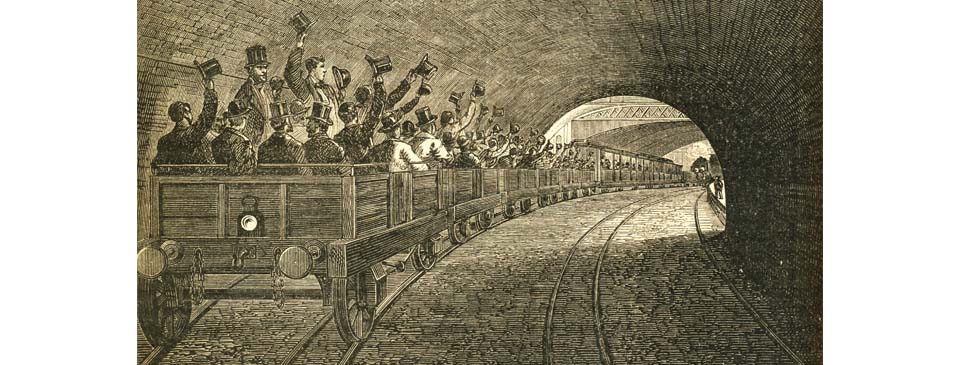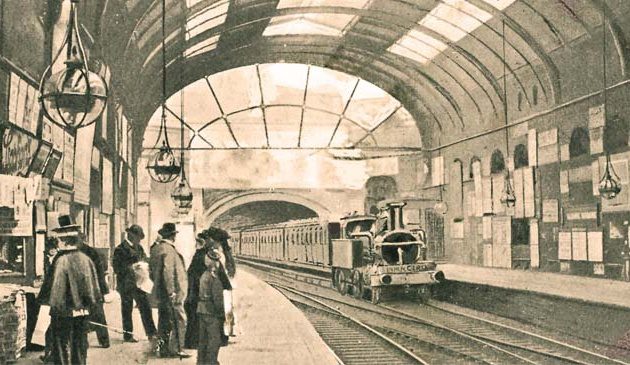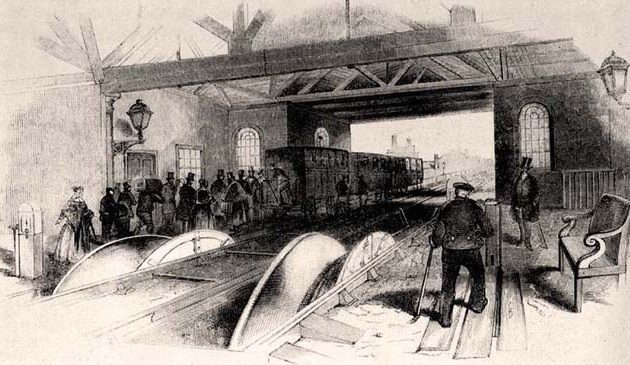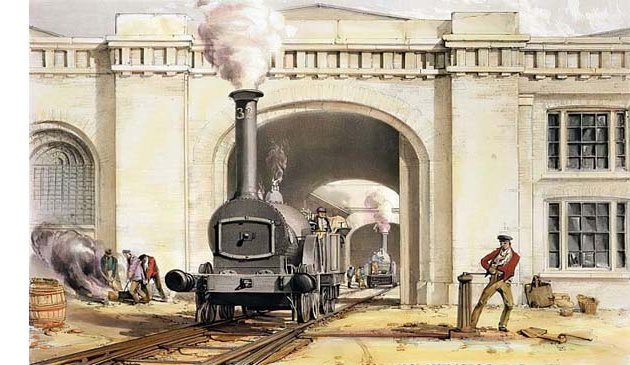London’s first underground railway

The image shows VIPs on a demonstration run on the Metropolitan Railway, perhaps prior to its opening. The carriages behind the locomotive are first-class while those at the back, in the foreground, are probably third-class. The train is running on the broad-gauge rails of the Great Western Railway. An inner rail can be seen, allowing standard gauge trains of the Great Northern and other companies to use the line.
The company provided links with the overground railways of the Great Western Railway from Paddington and Great Northern Railway from King’s Cross who then ran their trains onto the Metropolitan line, creating addition revenue in the form of tolls. Connections were gradually added to other railway networks, numbering seven by 1871, providing passengers with numerous destination possibilities. This continued into the early years of the 20th century. The GWR trains ran on broad gauge lines and the Great Northern on the more standard Stephenson gauge so the Metropolitan tracks initially had three rails to accommodate trains from the various companies.
As we have already seen, the underground line was originally considered to carry mail between the GPO sorting office and railway termini. In those early days it was actually used for carrying freight, including carcasses to Smithfield meat market, in addition to passengers. Freight traffic continued until after the Second World War. The line was initially operated by the Great Western Railway, supplying the locomotives and carriages, staff, and operating the booking offices. The trains were of the GWR’s broad gauge.
Locomotives were required to work in the tunnels without emitting steam or smoke. Daniel Gooch, the engineer for the Great Western, devised a system whereby the exhaust was returned to cold water tanks by pipes from the cylinders. The engines burnt coke instead of coal, which gave off less sulphur. However, the atmosphere in the tunnels was said to be unpleasant. In 1867 three people died from ‘choke damp’ and in the 1870s the company had to make ventilation shafts in the tunnels to allow air to escape.
The Metropolitan Railway was opened in January 1863 with a grand ceremony, attended by many VIPs. Trains ran every 15 minutes in each direction. It was a great novelty to travel under London by train and on the first day 30,000 passengers took a journey on the line, which would have been more if there were additional trains to carry them. In April the frequency was increased to six trains an hour during busy periods.
In August the GWR gave a month’s notice that it would cease to operate the line, which followed a dispute between the two parties regarding frequency of each of the company’s services. The Metropolitan had to very quickly acquire new trains and staff. The Great Northern and other railway companies quickly came to the rescue, fitting up some of their locomotives with the necessary condensing apparatus to run underground. New wooden carriages, with eight wheels, were ordered by the Metropolitan and arrived in October 1863. Until 1885 they were painted green with brass and copper. Carriages were of varnished teak and the top half of first class carriages painted white. The latter were quite luxurious, with each containing six compartments. Even second class, with eight compartments, had leather padded seats. Carriages were gas-lit, the gas carried in rubber bags on the roofs.
When the line opened a journey from one end to the other, from Paddington to Farringdon, could be made in 18 minutes. The Metropolitan was initially very successful. It normally ran 650 services per day, but with each locomotive pulling only four carriages with an average of 50 passengers on each train. In its first year nearly twelve million journeys were made, with a peak of 60,000 in one day, which is remarkable considering the limited route was also served by cheaper omnibuses. A dividend of 6.25 percent was paid to shareholders in the first year.
Fares of between five pence and nine pence for a return journey were affordable for the middle classes but expensive for lower-paid labourers. In 1861 the company was granted powers to extend the line east to Moorgate Street and double the tracks between King’s Cross and Farringdon. A condition of the grant was that the Metropolitan should provide lower fares for working men. In 1864 the company started to run two trains in each direction before 6am at a return fare of three pence, immediately attracting large numbers of workers.
Despite the dispute between the Metropolitan and GWR, they soon cooperated on a new venture: the Hammersmith & City line, to serve the growing suburbs of Shepherd’s Bush and Hammersmith, as well as Ladbroke Grove. As a sign of what was to come in the future, there were also intermediate stations at Latimer Road and Goldhawk Road, encouraging speculators to develop housing on the fields at those locations. The line opened in June 1864 and was initially worked by the GWR with broad-gauge trains. The following year a spur was opened to the West London line at Uxbridge Road, from where Latimer Road in now located. The Metropolitan took over the Hammersmith line in April 1865 and it then converted to standard gauge.
In December of that same year the line was extended in the east from Farringdon Street to Moorgate Street, with an intermediate station at Aldersgate. In 1866 the London, Chatham & Dover Railway also brought its line north, over the Thames at Blackfriars, to join the Metropolitan at Farringdon.


